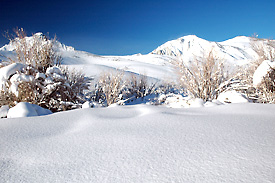Decreases in the Earth’s snow and ice cover over the past 30 years have exacerbated global warming more than models predict they should have, on average, new research from U-M shows.

Snowfall in the eastern Sierras. As the planet’s snow and sea ice cover shrinks, global warming is intensified to a degree greater than models have predicted, new research shows. Photo by Mark Flanner.
To conduct this study, Mark Flanner, assistant professor in the Department of Atmospheric, Oceanic and Space Sciences, analyzed satellite data showing snow and ice during the past three decades in the Northern Hemisphere, which holds the majority of the planet’s frozen surface area. The research is newly published online in Nature Geoscience.
Snow and ice reflect the sun’s light and heat back to space, causing an atmospheric cooling effect. But as the planet warms, more ice melts and in some cases, less snow falls, exposing additional ground and water that absorb more heat, amplifying the effects of warmer temperatures. This change in reflectance contributes to what’s called “albedo feedback,” one of the main positive feedback mechanisms adding fuel to the planet’s warming trend. The strongest positive feedback is from atmospheric water vapor, and cloud changes may also enhance warming.
“If the Earth were just a static rock, we could calculate precisely what the level of warming would be, given a perturbation to the system. But because of these feedback mechanisms we don’t know exactly how the climate will respond to increases in atmospheric carbon dioxide,” Flanner says.
“Our analysis of snow and sea ice changes over the last 30 years indicates that this cryospheric feedback is almost twice as strong as what models have simulated. The implication is that Earth’s climate may be more sensitive to increases in atmospheric carbon dioxide and other perturbations than models predict.”
The cryosphere is the planet’s layer of snow, sea ice and permanent ice sheets.
In the Northern Hemisphere since 1979, the average temperature rose by about 0.7 degrees Celsius, whereas the global average temperature rose by about 0.45 degrees, Flanner says.
To avoid the worst effects of climate change, the scientific consensus is that the global average temperature should stay within 2 degrees Celsius, or 3.6 degrees Fahrenheit, of pre-industrial levels. Scientists are still trying to quantify the extent to which the planet will warm as greenhouse gases accumulate in the atmosphere.

